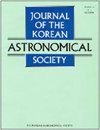MONITORING OBSERVATIONS OF H2O AND SiO MASERS TOWARD POST-AGB STARS
IF 0.8
4区 物理与天体物理
Q3 ASTRONOMY & ASTROPHYSICS
引用次数: 1
Abstract
We present the results of simultaneous monitoring observations of H₂O 6 1,6 –5 2,3 (22GHz) and SiO J=1–0, 2–1, 3–2 maser lines (43, 86, 129GHz) toward five post-AGB (candidate) stars, using the 21-m single-dish telescopes of the Korean VLBI Network. Depending on the target objects, 7 – 11 epochs of data were obtained. We detected both H₂O and SiO maser lines from four sources: OH16.1−0.3, OH38.10−0.13, OH65.5+1.3, and IRAS 19312+1950. We could not detect H₂O maser emission toward OH13.1+5.1 between the late OH/IR and post-AGB stage. The detected H₂O masers show typical double-peaked line profiles. The SiO masers from four sources, except IRAS 19312+1950, show the peaks around the stellar velocity as a single peak, whereas the SiO masers from IRAS 19312+1950 occur above the red peak of the H₂O maser. We analyzed the properties of detected maser lines, and investigated their evolutionary state through comparison with the full widths at zero power. The distribution of observed target sources was also investigated in the IRAS two-color diagram in relation with the evolutionary stage of post-AGB stars. From our analyses, the evolutionary sequence of observed sources is suggested as OH65.5+1.3 → OH13.1+5.1→ OH16.1−0.3 → OH38.10−0.13, except for IRAS 19312+1950. In addition, OH13.1+5.1 from which the H₂O maser has not been detected is suggested to be on the gateway toward the post-AGB stage. With respect to the enigmatic object, IRAS 19312+1950, we could not clearly figure out its nature. To properly explain the unusual phenomena of SiO and H₂O masers, it is essential to establish the relative locations and spatial distributions of two masers using VLBI technique. We also include the 1.2 – 160 μm spectral energy distribution using photometric data from the following surveys: 2MASS, WISE, MSX, IRAS, and AKARI (IRC and FIS). In addition, from the IRAS LRS spectra, we found that the depth of silicate absorption features shows significant variations depending on the evolutionary sequence, associated with the termination of AGB phase mass-loss.对后agb恒星的H2O和SiO脉泽的监测观测
利用韩国VLBI网络的21米单碟望远镜,对5颗后agb(候选)恒星进行了H₂O 6 1,6 - 5,2,3 (22GHz)和SiO J=1 - 0,2 - 1, 3 - 2脉泽线(43,86,129 ghz)的同步监测观测结果。根据不同的目标对象,获得了7 ~ 11个历元的数据。我们检测了四个源的H₂O和SiO脉泽线:OH16.1−0.3,OH38.10−0.13,OH65.5+1.3和IRAS 19312+1950。在OH/IR后期和agb后阶段,我们没有检测到OH13.1+5.1方向的H₂O脉泽发射。探测到的H₂O脉泽呈现出典型的双峰谱线。除了IRAS 19312+1950外,来自四个源的SiO脉泽在恒星速度附近显示为单峰,而来自IRAS 19312+1950的SiO脉泽出现在h2o脉泽的红色峰上方。我们分析了探测到的脉泽线的特性,并通过与零功率下脉泽线全宽度的比较研究了它们的演化状态。在IRAS双色图中研究了观测到的靶源分布与后agb恒星演化阶段的关系。分析表明,除IRAS 19312+1950外,所有观测源的演化顺序为:OH65.5+1.3→OH13.1+5.1→OH16.1−0.3→OH38.10−0.13。此外,未检测到H₂O脉泽的OH13.1+5.1可能处于agb后阶段的门户。对于IRAS 19312+1950这个神秘的天体,我们无法清楚地弄清楚它的性质。为了正确解释SiO和h2o脉泽的异常现象,必须利用VLBI技术建立两个脉泽的相对位置和空间分布。我们还使用以下调查的光度数据包括1.2 - 160 μm光谱能量分布:2MASS, WISE, MSX, IRAS和AKARI (IRC和FIS)。此外,从IRAS - LRS光谱中,我们发现硅酸盐吸收特征的深度随演化顺序而发生显著变化,这与AGB相质量损失的终止有关。
本文章由计算机程序翻译,如有差异,请以英文原文为准。
求助全文
约1分钟内获得全文
求助全文
来源期刊

Journal of the Korean Astronomical Society
地学天文-天文与天体物理
CiteScore
1.30
自引率
10.00%
发文量
0
审稿时长
>12 weeks
期刊介绍:
JKAS is an international scientific journal publishing papers in all fields of astronomy and astrophysics. All manuscripts are subject to the scrutiny of referees. Manuscripts submitted to JKAS must comply with the ethics policy of JKAS. Six regular issues are published each year on February 28, April 30, June 30, August 31, October 31, and December 31. One year''s issues compose one volume.
 求助内容:
求助内容: 应助结果提醒方式:
应助结果提醒方式:


